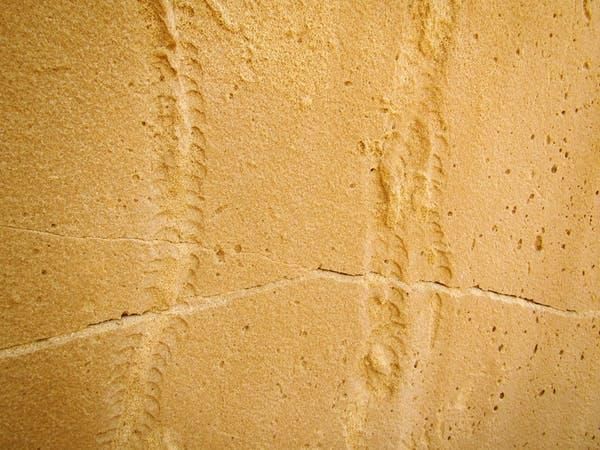Baby Sea Turtles’ Fossilized Tracks Found in South Africa
Researchers recorded trackways left by relatives of modern loggerhead and leatherback turtles
/https://tf-cmsv2-smithsonianmag-media.s3.amazonaws.com/filer/2d/70/2d703f64-a072-4808-bd7d-457fd18f366c/leatherbacks_crawling_to_the_sea.jpg)
Some 100,000 years ago, groups of sea turtle hatchlings converged on the ocean simultaneously, counting on the phenomenon of safety in numbers to protect them from lurking predators.
Now, a team of international researchers reports in the journal Quarternary Research, these juvenile turtles’ tracks—unusually well-preserved given the fleeting nature of the moments in which they were made—have resurfaced at sites across South Africa’s Cape South Coast. Per Atlas Obscura’s Sabrina Imbler, the markings represent the first documented examples of fossilized sea turtle trackways; previously, scientists have only found trails left by ancient freshwater species.
As Imbler writes, study co-author Jan De Vynck, a paleontologist at Nelson Mandela University’s African Centre for Coastal Palaeoscience, initially chanced upon the tracks while searching for prehistoric fossils in 2016. Trailing along the surface of a large rock, the seven roughly parallel paths point southward, leading De Vynck and his colleagues to posit that their creators were traveling toward the sea.
According to a Conversation article by fellow co-authors Charles Helm, also of Nelson Mandela University, and Martin Lockley of the University of Colorado Denver, this first site has since been supplemented by three additional hotbeds of sea turtle hatchling activity. Two of the sites are located within several kilometers of the first fossil find, while the third is situated around 100 kilometers, or 62 miles, to the east. It’s possible the last location housed a nest that served as some of the hatchlings’ starting point.
Per the study, a set of parallel trackways exhibiting an alternating gait was likely left by relatives of the modern loggerhead turtle. Another wider trackway is more consistent with that of the leatherback turtle. Since these ancient turtle variations have never been previously described, the researchers named them Australochelichnus agulhasii and Marinerichnus latus, respectively.

Atlas Obscura’s Imbler explains that Lockley, De Vynck, Helm and Hayley Cawthra of Nelson Mandela University identified the fossils as sea turtle tracks on the basis of their distinctive patterns, coastal deposit setting and parallel layout. Adult turtles often lay their eggs in coastal deposits, and parallel trackways are suggestive of simultaneous departure from one point of origin.
“It’s kind of amazing that the turtles would make these tracks for just literally a couple of minutes and the fossil record has captured this very unique activity,” Lockley tells Imbler. “It’s literally the first steps these animals take.”
Until now, fossil evidence of prehistoric turtles has been largely limited to tracks left by freshwater species in Europe, North America and Asia. Although Lockley and Helm note that giant sea turtle tracks may be present in the Jurassic rocks of western Europe, these markings were made by adults swimming across the sea bed, not juveniles rushing toward the ocean.
According to the Conversation article, the trackways—probably preserved by wind-blown dry sand blanketing paths left in wet sand—paint a helpful portrait of South Africa’s Pleistocene Epoch ecosystem. Today, loggerheads and leatherbacks nest mainly along the country’s northeastern coast rather than the Cape South Coast. The researchers attribute this shift to natural climate change, as well as human hunting.
Speaking with Atlas Obscura, Lockley emphasizes the importance of studying fossilized tracks, which can provide more information on animals’ behavior than fossilized bone.
“I often joke with my colleagues that people who study bones and skeletons just study death and decay,” he says. “But people who study tracks are studying the living animal.”
/https://tf-cmsv2-smithsonianmag-media.s3.amazonaws.com/accounts/headshot/mellon.png)
/https://tf-cmsv2-smithsonianmag-media.s3.amazonaws.com/accounts/headshot/mellon.png)